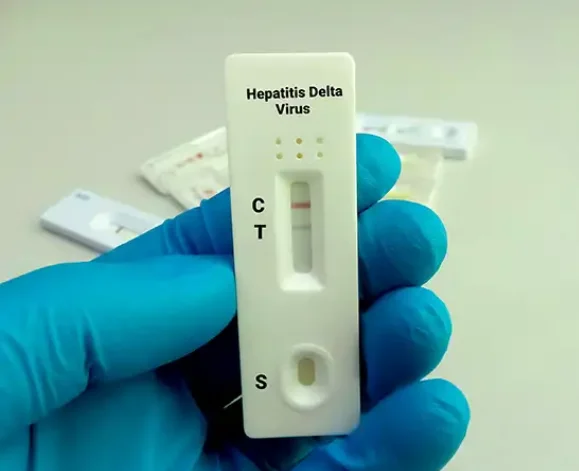- Written by Adithi PH
- With quotes from Dr Shiran Shetty (gastroenterologist), Dr Chetan Kalal (hepatologist).
- HDV can only infect individuals who are already infected with HBV, either through simultaneous co-infection or subsequent superinfection.
Hepatitis D Virus (HDV), also known as the Hepatitis Delta Virus, is a unique and serious pathogen that leads to the most severe form of viral hepatitis. Unlike other hepatitis viruses, HDV requires co-infection with the Hepatitis B Virus (HBV) to replicate and infect, resulting in chain of liver complications beginning with liver inflammation, fibrosis (scarring of the liver), which can further result in cirrhosis (severe scarring) and hepatocellular carcinoma (HCC), a type of liver cancer.
A 2020 study published in The Lancet Global Health assessed the global prevalence of Hepatitis D. It involved analysing data from over 120,000 individuals across various geographical regions. The results showed that HDV affects an estimated 12 million people globally. This shows the need for improved surveillance and prevention strategies for HDV due to the high risk of its progression to liver cirrhosis and liver cancer.
The study says that globally, among the general population the prevalence of HDV is 0.16 %. However, WHO data, mentions that Hepatitis D virus (HDV) affects globally nearly 5% of people who have a chronic infection with hepatitis B virus (HBV).
Structural differences between HDV and other hepatitis viruses
Dr Shiran Shetty, professor, department of gastroenterology and deputy medical superintendent, Kasturba Hospital, Manipal explains that HDV is distinct from other hepatitis viruses like Hepatitis A, B, C, and E, in its structure and infection process. “Unlike other hepatitis viruses that have their protein coats, HDV is a defective virus that cannot replicate independently. HDV cannot replicate on its own and requires the presence of the hepatitis B virus (HBV) to replicate and cause infection. HBV is a DNA virus that infects the liver,” he said.
When it comes to genetic structure, the genome of HDV is a single-stranded circular RNA molecule whereas other hepatitis viruses have different genomic structures. “Hepatitis D virus (HDV) is a defective virus that unlike other hepatitis viruses, does not have its own envelope protein; instead, it utilizes HBV’s envelope proteins for its assembly and secretion,” says Dr Chetan Kalal, Program Director of Liver, Pancreas, and Intestine Transplantation, Nanavati Max Super Specialty Hospital, Mumbai.
HDV can only infect individuals who are already infected with HBV, either through simultaneous co-infection or subsequent superinfection. Dr Shetty explains, “co-infections occur when both viruses are acquired at the same time, while superinfection occurs when someone who is already chronically infected with HBV acquires HDV.” In both cases, the severity of liver disease is typically worse than with HBV alone.
HDV’s reliance on HBV means it cannot infect or replicate in people who are not infected with HBV.
Primary Modes of Transmission
In rare cases a person may get infected with HDV even in the absence of HBV infection. Experts explain that the HDV can be transmitted from an HDV infected person to others through means of sexual contact, injection drug use (sharing needles and syringes contaminated with the blood of an HDV-infected person), transmission from mother to child during childbirth, and exposure to contaminated blood or blood products.
Dr Kalal adds that people who are already infected with HBV can acquire HDV through exposure to contaminated blood or bodily fluids.
Symptoms and disease progression
The symptoms of HDV include fatigue, jaundice, abdominal pain, nausea, and joint pain, but experts add that disease progression patterns depend on whether the person is co-infected or superinfected, and the presence of other liver conditions. “HDV can lead to acute hepatitis, fulminant hepatitis, cirrhosis, and liver cancer,” says Dr Shetty.
In co-infections, acute hepatitis may resolve without significant complications, but in superinfections, there is a higher risk of progression to chronic liver disease and cirrhosis.
“Chronic HDV infection increases the risk of developing cirrhosis, liver decompensation, and hepatocellular carcinoma compared to chronic HBV infection alone,” adds Dr Kalal.
Managing and treating HDV
“HDV’s dependence on HBV makes it challenging to treat and control as the treatment options for HDV infection are limited,” says Dr Shetty. He adds that while currently there are no approved specific antiviral therapies for HDV infection, management strategies focus on controlling HBV replication, preventing liver damage, and managing complications associated with HDV infection.
Some of the recommended treatment options and management strategies according to experts are:
Interferon-based therapy: Interferons are lab made proteins used in the treatment against HDV. It is the only treatment with proven efficacy against HDV, but response rates vary among individuals.
HBV antiviral therapy: Since HDV requires HBV for its replication, treatment of the latter may indirectly suppress the HDV replication by reducing HBV DNA levels.
Liver transplantation: This option may be considered for people with end-stage liver disease. However, HDV can recur in the transplanted liver, and outcomes may be less favorable compared to liver transplantation for other indications.
Hepatitis delta virus: Precautions to take
Dr Shetty explains that preventing HDV transmission involves similar strategies to those used for preventing other bloodborne infections, like safe injection practices, using contraceptive barriers during sexual intercourse, screening blood and blood products for HDV, and promoting HBV vaccination to prevent HBV infection, which can subsequently prevent HDV infection.
However, there is no vaccine against HDV.
“Screening high-risk populations, such as individuals with HBV infection or injection drug users, for HDV infection is crucial for early detection and management,” adds Dr Kalal.
Takeaways
- Hepatitis Delta Virus relies on the envelope proteins of Hepatitis B virus to replicate and infect.
- Transmission occurs mainly through direct exposure to blood or bodily fluids containing the virus.
- The disease can vary from asymptomatic to severe hepatitis, often progressing rapidly to chronic liver disease.
- Preventive measures such as HBV vaccination, safe injection practices, and high-risk population screening are crucial. There is no vaccine against HDV.
- Interferon-based therapy, HBV antiviral therapy, and liver transplantation are some treatment options for HDV.


